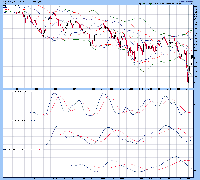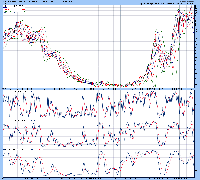|
|||
In the Future When Interest Rates Will Soar, Consumers will be Sore TooDavid Petch At the present, governments around the globe are printing money as if there were no tomorrow in order to try and prevent debt-laden banks from going under and trying to stimulate the fractional reserve banking system. The past 20 years of economic growth has been based on a “Pay it Forward” basis…someone gets a new couch or car and ends up paying for it over a defined period of time. The expansion of credit in turn allowed for false consumption because most people never really had the money in hand. In the past, whenever any purchases were made, most people either saved up until they had money in hand or used “Lay Away” programs for purchase (an individual would make biweekly payments until an item was paid for in full and then taken home). As the global economy continues to shrink and get worse, the first knee-jerk reaction is to start saving, which is evident in the US as personal savings rates reached 6.9% year over year. When prices decline, it makes sense to save money as it does not make any sense to buy things when there is economic uncertainty. During periods of economic contractions, the absolutely worst sectors to be in are retail or any consumer-related businesses that people do not absolutely require, such as getting manicures and pedicures, furniture, cars, etc. Areas that tend to maintain somewhat of a stable environment are Pharmaceutical (especially those that provide life-saving drugs), food and energy sectors. One of the hardest sectors that will get hit in Canada in the coming years will be the government sector. There is so much money being pumped into government up here at present that it is serving as an artificial inflator of the economy. When the S&P eventually bottoms in late 2009/early 2010, the economic bottom should follow history and be in place 12-18 months afterwards. This suggests that mid to late 2011 should mark the bottom of the global economic recession from a bottom in residential real estate…note: commercial real estate has recently succumbed to the global recession, so it is likely the consumer will bottom before businesses do. In other words, the bottom of the economy could be flat for a subsequent 1-2 years until consumers retrench from their bunkers and again begin spending. Analysis today will focus on the 10 Year US Treasury Index and how it should behave over the course of the next 6-12 months. The daily chart of the 10 Year US Treasury Index is shown below, with upper Bollinger bands above the index, indicating a top was put in place. All lower Bollinger bands are rising to meet the index, suggestive the TNX just started a downward correction. Full stochastics 1, 2 and 3 are shown below in order of descent, with the %K beneath the %D in all three instances. Based upon positioning of the %K in stochastic 2, the TNX could be in a corrective decline for another 4-6 weeks. The daily chart remains a sell. Figure 1 The weekly chart of the TNX is shown below, with upper and lower Bollinger band still compressing, suggestive the top in April 2008 is still being consolidated. Full stochastics 1, 2 and 3 are shown below in order of descent, with the %K above the %D in all three instances. At present, the %K in stochastic 1 has curled down, suggestive that a short-term top may be in place. Figure 2 The monthly chart of the TNX is shown below, with lower Bollinger bands all beneath the index and curling up, suggestive a bottom was put in place back at the start of 2009. Upper and lower Bollinger bands have a significant spread between them, suggestive that there could be a 2-3 consolidation of rates between 3-7% before breaking higher. I must note that if the economy gets worse than expected, the TNX could pop up to 6% sooner rather than later. Full stochastics 1, 2 and 3 are shown below in order of descent, with the %K above the %D in stochastic 1. Given the low positioning of the %K for stochastics 2 and 3, the TNX will have a multi-year run when things turn up. Based upon extrapolation of the %K, it could be another 2 years before the %K crosses above the %K in stochastic 3. Figure 3 The 10 Year/2 Year US Treasury Index ratio is shown below, with lower Bollinger bands declining beneath the closing value, suggestive a bottom was put in place. Full stochastics 1, 2 and 3 are shown below in order of descent, with the %K above the %D in stochastic 1. There is likely another 3-4 weeks of consolidation before the ratio heads higher. At present, it seems like shorter term rates could rise faster than longer-term rates. Figure 4 The Elliott Wave count of the TNX is shown below, with the thought pattern in wave [E], likely forming a neutral triangle…only time will tell if this is correct, but if the TNX declines to around 3 to 3.10, it could blast higher over the course of the next 8-12 months. Figure 5 ### Jun 27, 2009 |





